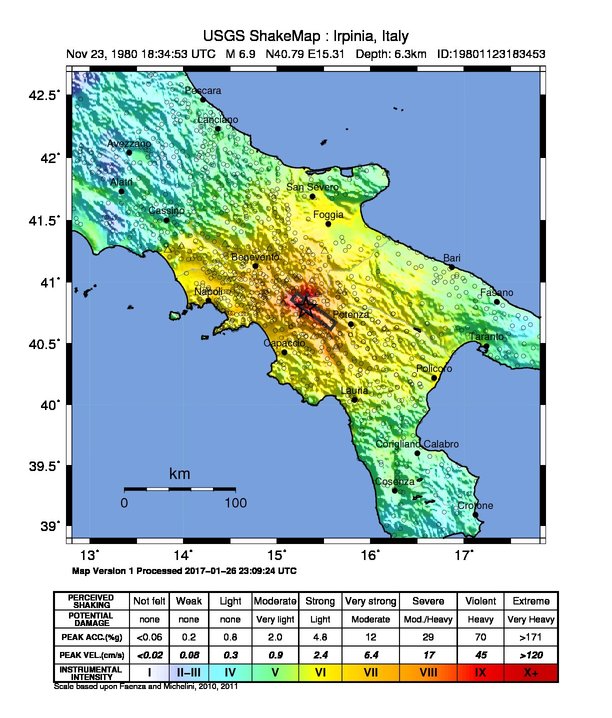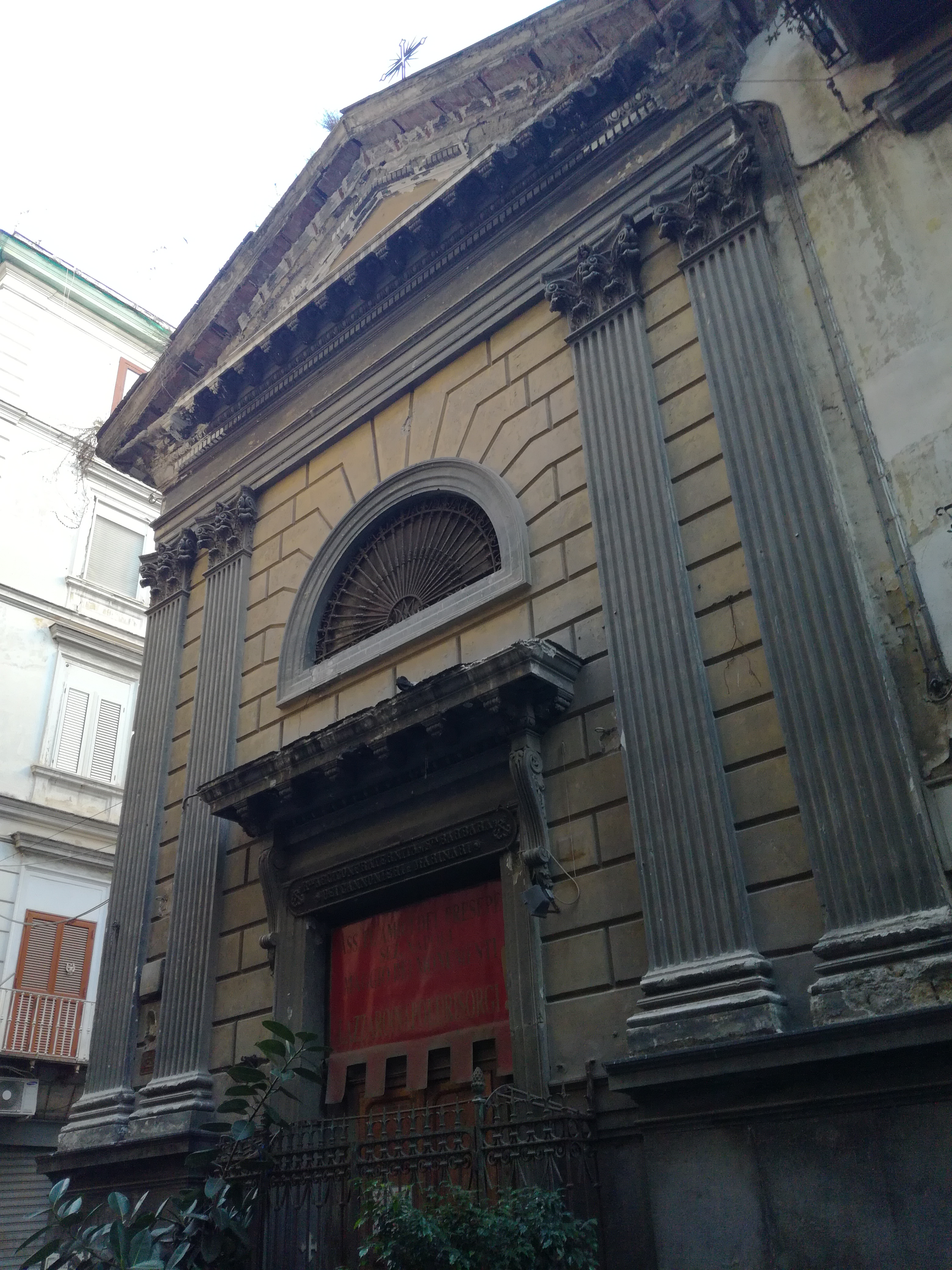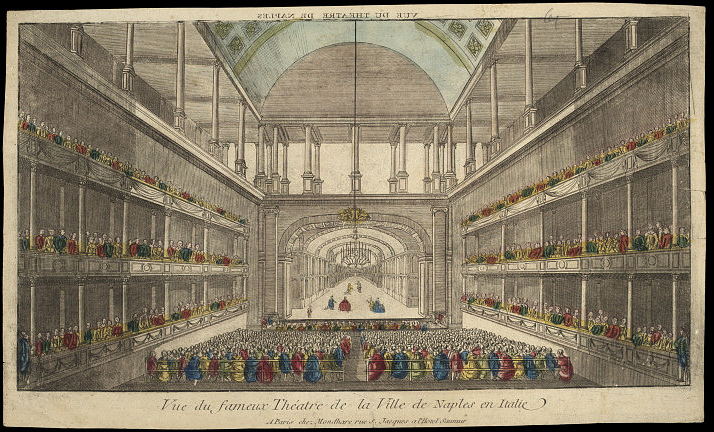|
Graziella Al Porto Napoli
The church of the Graziella al Porto Napoli or Santa Maria delle Grazie al Porto Napoli is a small Roman Catholic church in Naples, Italy. The church is just behind the church of Pietà dei Turchini, on vico Graziella al Porto. It is accessible through narrow alleys from via Medina, along the church of San Diego all'Ospedaletto and the former Royal Conservatory, but also by pedestrian alleys from via Guglielmo San Felice and via De Pretis. It is located in the rione San Giuseppe Carità. In 1737, the architect Angelo Carasale, in order to signal his gratitude to the providence granted by the Virgin, decided to erect this church, initially named Santa Maria delle Grazie. Carasale had found success when he was granted direction of the Teatro San Bartolomeo by King Charles III. The church was in the custody of the Mercedarian order until 1801, when it was transferred to the Confraternity of Santi Bernardo e Margherita. That group merged in 1859 with the Confraternity of Santa Maria ... [...More Info...] [...Related Items...] OR: [Wikipedia] [Google] [Baidu] |
Italy
Italy ( it, Italia ), officially the Italian Republic, ) or the Republic of Italy, is a country in Southern Europe. It is located in the middle of the Mediterranean Sea, and its territory largely coincides with the homonymous geographical region. Italy is also considered part of Western Europe, and shares land borders with France, Switzerland, Austria, Slovenia and the enclaved microstates of Vatican City and San Marino. It has a territorial exclave in Switzerland, Campione. Italy covers an area of , with a population of over 60 million. It is the third-most populous member state of the European Union, the sixth-most populous country in Europe, and the tenth-largest country in the continent by land area. Italy's capital and largest city is Rome. Italy was the native place of many civilizations such as the Italic peoples and the Etruscans, while due to its central geographic location in Southern Europe and the Mediterranean, the country has also historically been home ... [...More Info...] [...Related Items...] OR: [Wikipedia] [Google] [Baidu] |
1980 Irpinia Earthquake
The 1980 Irpinia earthquake ( it, Terremoto dell'Irpinia) took place in Italy on 23 November 1980, with a moment magnitude of 6.9 and a maximum Mercalli intensity of X (''Extreme''). It left at least 2,483 people dead, at least 7,700 injured, and 250,000 homeless. Event The quake struck at 18:34 UTC (19:34 local), centered on the village of Castelnuovo di Conza, Campania, Southern Italy. The first jolt was followed by 90 aftershocks. There were three main shocks, each with epicenters in a different place, within 80 seconds. The largest shock registered a peak acceleration of 0.38g, with 10 seconds of motion greater than 0.1g. The three main shocks combined produced 70 seconds of shaking greater than 0.01g. Thus the shaking was severe and lasted a long time. Towns in the province of Avellino were hit the hardest. In Sant'Angelo dei Lombardi, 300 were killed, including 27 children in an orphanage, and eighty percent of the town was destroyed and many historical buildings were lef ... [...More Info...] [...Related Items...] OR: [Wikipedia] [Google] [Baidu] |
Baroque Architecture In Naples
The Baroque (, ; ) is a Style (visual arts), style of Baroque architecture, architecture, Baroque music, music, Baroque dance, dance, Baroque painting, painting, Baroque sculpture, sculpture, poetry, and other arts that flourished in Europe from the early 17th century until the 1750s. In the territories of the Spanish and Portuguese empires including the Iberian Peninsula it continued, together with new styles, until the first decade of the 19th century. It followed Renaissance art and Mannerism and preceded the Rococo (in the past often referred to as "late Baroque") and Neoclassicism, Neoclassical styles. It was encouraged by the Catholic Church as a means to counter the simplicity and austerity of Protestant architecture, art, and music, though Lutheran art#Baroque period, Lutheran Baroque art developed in parts of Europe as well. The Baroque style used contrast, movement, exuberant detail, deep colour, grandeur, and surprise to achieve a sense of awe. The style began at the s ... [...More Info...] [...Related Items...] OR: [Wikipedia] [Google] [Baidu] |
18th-century Roman Catholic Church Buildings In Italy
The 18th century lasted from January 1, 1701 ( MDCCI) to December 31, 1800 ( MDCCC). During the 18th century, elements of Enlightenment thinking culminated in the American, French, and Haitian Revolutions. During the century, slave trading and human trafficking expanded across the shores of the Atlantic, while declining in Russia, China, and Korea. Revolutions began to challenge the legitimacy of monarchical and aristocratic power structures, including the structures and beliefs that supported slavery. The Industrial Revolution began during mid-century, leading to radical changes in human society and the environment. Western historians have occasionally defined the 18th century otherwise for the purposes of their work. For example, the "short" 18th century may be defined as 1715–1789, denoting the period of time between the death of Louis XIV of France and the start of the French Revolution, with an emphasis on directly interconnected events. To historians who expand ... [...More Info...] [...Related Items...] OR: [Wikipedia] [Google] [Baidu] |
Former Churches In Naples
A former is an object, such as a template, gauge or cutting die, which is used to form something such as a boat's hull. Typically, a former gives shape to a structure that may have complex curvature. A former may become an integral part of the finished structure, as in an aircraft fuselage, or it may be removable, being using in the construction process and then discarded or re-used. Aircraft formers Formers are used in the construction of aircraft fuselage, of which a typical fuselage has a series from the nose to the empennage, typically perpendicular to the longitudinal axis of the aircraft. The primary purpose of formers is to establish the shape of the fuselage and reduce the column length of stringers to prevent instability. Formers are typically attached to longerons, which support the skin of the aircraft. The "former-and-longeron" technique (also called stations and stringers) was adopted from boat construction, and was typical of light aircraft built until the ... [...More Info...] [...Related Items...] OR: [Wikipedia] [Google] [Baidu] |
Giuseppe Bonito
Giuseppe Bonito (11 January 1707 – 9 May 1789) was a Neapolitan painter of the Rococo period. Giuseppe Bonito is known for genre depictions on canvas. Many of Gaspare Traversi's paintings had previously been attributed to Bonito. Biography Bonito was born at Castellammare di Stabia, and, like Traversi, was a student at the large studio of Francesco Solimena. One of his contemporaries there was Gaspare Traversi. Bonito represented urban scenes with folklore details and figures of commedia dell'arte. Between the 1736 and 1742 Bonito worked for the House of Borbon in the royal Palace of Portici. He also painted portraits including one of Maria Amalia of Saxony, wife of the Charles VII, king of Naples and Charles III of Spain. An altarpiece of the ''Immaculate Conception'' was painted in 1789 for the chapel of Royal Palace of Caserta. One of his pupils was Angelo Mozzillo. He died in Naples. Gallery Giuseppe Bonito (attr) Gruppenportrait von drei adeligen Kindern.jpg, ... [...More Info...] [...Related Items...] OR: [Wikipedia] [Google] [Baidu] |
San Pietro Nolasco
Peter Nolasco (1189 – 6 May 1256), ''Pere Nolasc'' in Catalan, ''Pierre Nolasque'' in French and ''Pedro Nolasco'' in Spanish, is a Catholic saint, born at Mas-des-Saintes-Puelles, Languedoc, today's France, although some historians claim he was born in Barcelona (see ''Encyclopædia Britannica''). It is clear that Nolasco was in Barcelona when he was a teenager, became part of an army fighting the Moors in the Iberian peninsula, and was appointed tutor to the young king, James I of Aragon. In 1218 he formed a congregation of men that became the Royal and Military Order of Our Lady of Mercy of the Redemption of the Captives (the Mercedarians) with approval by Pope Gregory IX in 1230. Background Between the eighth and the fifteenth centuries, medieval Europe was in a state of intermittent warfare between the Christian kingdoms of southern Europe and the Muslim polities of North Africa, Southern France, Sicily and portions of Spain. According to James W. Brodman, the threat of ... [...More Info...] [...Related Items...] OR: [Wikipedia] [Google] [Baidu] |
San Giacomo Degli Italiani, Naples
San Giacomo degli Italiani (once the church of San Giacomo dei Pisani) is a church located on Via Depretis in Naples, Italy. First built in 1238, in the Swabia (Bavaria), Swabian era, and given in gratitude to merchants from the Republic of Pisa, who had recently been victorious in a battle against a Saracen navy. At the beginning of the 15th century the church was turned over to the knights of the Order of the Spade (Ordine della Spada). Subsequently circa 1575, the church and the order of the Spada was forbidden to carry out their investitures by the viceroy Iñigo López de Mendoza y Mendoza, Íñigo López de Hurtado de Mendoza, and the ceremonies were moved to the San Giacomo degli Spagnoli, Naples, San Giacomo degli Spagnoli. In 1775, the church was granted to the ''Complementari'', who restored the church in a Baroque architecture, Baroque style. The present church of San Giacomo was reconstructed by reopening an alternative older portal, surmounted by a coat of arms of a ... [...More Info...] [...Related Items...] OR: [Wikipedia] [Google] [Baidu] |
Santa Barbara Dei Cannonieri, Naples
The church of Saint Barbara of the Gunners or or is a small religious edifice in central Naples, Italy. It is located on Rua Catalana, near the church of San Giacomo degli Italiani, Naples, San Giacomo degli Italiani. The church embedded in the Castel Nuovo of Naples, has also been called ''Santa Barbara'' (or by other sources, San Sebastiano). History This church has hosted many groups over the years. Initially built over the remains of a 14th-century church by commission of the Serguidone family; it was called Santa Maria dell' Incoronatella, (to distinguish it from the larger church of the Santa Maria Incoronata, Naples, Incoronata). By the late 16th century, the church housed the confraternity of the Bianchi, who founded a music conservatory in 1583, called the Conservatory of the Pietà. This group soon moved to a new site on Via Medina. The church became a parish church. In the early 17th century, it housed another confraternity, that of Santa Maria della Pietà, and the ... [...More Info...] [...Related Items...] OR: [Wikipedia] [Google] [Baidu] |
Order Of The Blessed Virgin Mary Of Mercy
The Royal, Celestial and Military Order of Our Lady of Mercy and the Redemption of the Captives ( la, Ordo Beatae Mariae de Mercede Redemptionis Captivorum, abbreviated O. de M.), also known as the Mercedarians, is a Catholic mendicant order established in 1218 by Peter Nolasco in the city of Barcelona, at that time in the Crown of Aragon, for the redemption of Christian captives. Its members are most commonly known as Mercedarian friars or nuns. One of the distinguishing marks of the Order of the Blessed Virgin Mary of Mercy is that, since its foundation, its members are required to take a fourth vow: to die, if necessary, for another who is in danger of losing their faith. The Order exists today in 17 countries. General background Between the eighth and the fifteenth centuries, medieval Europe was in a state of intermittent warfare between the Christian kingdoms of southern Europe and the Muslim polities of North Africa, Southern France, Sicily and Moorish portions of Spain. ... [...More Info...] [...Related Items...] OR: [Wikipedia] [Google] [Baidu] |
Naples
Naples (; it, Napoli ; nap, Napule ), from grc, Νεάπολις, Neápolis, lit=new city. is the regional capital of Campania and the third-largest city of Italy, after Rome and Milan, with a population of 909,048 within the city's administrative limits as of 2022. Its province-level municipality is the third-most populous metropolitan city in Italy with a population of 3,115,320 residents, and its metropolitan area stretches beyond the boundaries of the city wall for approximately 20 miles. Founded by Greeks in the first millennium BC, Naples is one of the oldest continuously inhabited urban areas in the world. In the eighth century BC, a colony known as Parthenope ( grc, Παρθενόπη) was established on the Pizzofalcone hill. In the sixth century BC, it was refounded as Neápolis. The city was an important part of Magna Graecia, played a major role in the merging of Greek and Roman society, and was a significant cultural centre under the Romans. Naples served a ... [...More Info...] [...Related Items...] OR: [Wikipedia] [Google] [Baidu] |
Teatro San Bartolomeo, Naples
Theatres for diverse musical and dramatic presentations began to open in Naples, Italy, in the mid-16th century as part of the general Spanish cultural and political expansion into the kingdom of Naples, which had just become a vicerealm of Spain. None of the early theaters still function as such, having been replaced by later facilities from the mid-18th century onwards. Neapolitan theatres first built in the 16th and 17th centuries include: Teatro della Commedia Vecchia Built around 1550, the Commedia Vecchia was the first public theatre in Naples. It was the professional home to acting troupes from Spain "playing the provinces," and it provided a stage for the improvised antics of the masked and costumed figures in the then innovative Italian commedia dell'arte. In its heyday, the theatre was so successful that the government put a tax on their proceeds to finance the Casa dei Incurabili, a home for people with incurable diseases. The theatre was acquired in 1587 by a consortium ... [...More Info...] [...Related Items...] OR: [Wikipedia] [Google] [Baidu] |




